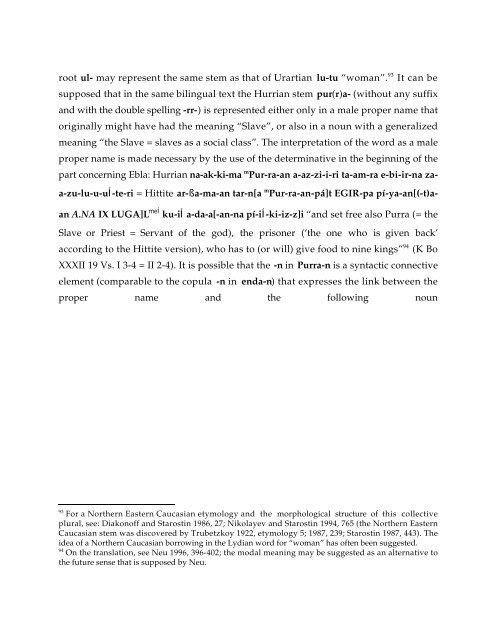Comparative Notes on Hurro-Urartian, Northern Caucasian
Comparative Notes on Hurro-Urartian, Northern Caucasian
Comparative Notes on Hurro-Urartian, Northern Caucasian
Create successful ePaper yourself
Turn your PDF publications into a flip-book with our unique Google optimized e-Paper software.
oot ul- may represent the same stem as that of <strong>Urartian</strong> lu-tu “woman”. 93 It can be<br />
supposed that in the same bilingual text the Hurrian stem pur(r)a- (without any suffix<br />
and with the double spelling -rr-) is represented either <strong>on</strong>ly in a male proper name that<br />
originally might have had the meaning “Slave”, or also in a noun with a generalized<br />
meaning “the Slave = slaves as a social class”. The interpretati<strong>on</strong> of the word as a male<br />
proper name is made necessary by the use of the determinative in the beginning of the<br />
part c<strong>on</strong>cerning Ebla: Hurrian na-ak-ki-ma m Pur-ra-an a-az-zi-i-ri ta-am-ra e-bi-ir-na za-<br />
a-zu-lu-u-uÍ-te-ri = Hittite ar-ßa-ma-an tar-n[a m Pur-ra-an-pá]t EGIR-pa pí-ya-an[(-t)a-<br />
an A.NA IX LUGA]L meÍ ku-iÍ a-da-a[-an-na pí-iÍ-ki-iz-z]i “and set free also Purra (= the<br />
Slave or Priest = Servant of the god), the pris<strong>on</strong>er (‘the <strong>on</strong>e who is given back’<br />
according to the Hittite versi<strong>on</strong>), who has to (or will) give food to nine kings” 94 (K Bo<br />
XXXII 19 Vs. I 3-4 = II 2-4). It is possible that the -n in Purra-n is a syntactic c<strong>on</strong>nective<br />
element (comparable to the copula -n in enda-n) that expresses the link between the<br />
proper name and the following noun<br />
93 For a <strong>Northern</strong> Eastern <strong>Caucasian</strong> etymology and the morphological structure of this collective<br />
plural, see: Diak<strong>on</strong>off and Starostin 1986, 27; Nikolayev and Starostin 1994, 765 (the <strong>Northern</strong> Eastern<br />
<strong>Caucasian</strong> stem was discovered by Trubetzkoy 1922, etymology 5; 1987, 239; Starostin 1987, 443). The<br />
idea of a <strong>Northern</strong> <strong>Caucasian</strong> borrowing in the Lydian word for “woman” has often been suggested.<br />
94 On the translati<strong>on</strong>, see Neu 1996, 396-402; the modal meaning may be suggested as an alternative to<br />
the future sense that is supposed by Neu.





